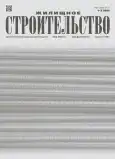Identification of zones with potential for transit-oriented development: a case study of Volgograd
- Authors: Matovnikov V.S.1, Vaitens A.G.1
-
Affiliations:
- St Petersburg State University of Architecture and Civil Engineering
- Issue: No 1-2 (2025)
- Pages: 74-80
- Section: Articles
- URL: https://modernonco.orscience.ru/0044-4472/article/view/677193
- DOI: https://doi.org/10.31659/0044-4472-2025-1-2-74-80
- ID: 677193
Cite item
Abstract
Volgograd is a linear city, the development of which, due to the remoteness of the peripheral areas from the center, is especially dependent on the efficiency of high-speed transport links. One of the solutions may be the implementation of the provisions of the concept of transit-oriented development (TOD), which assumes the orientation of urban planning on creating conditions for the most efficient and convenient use of public transport. The article proposes a method for identifying zones with potential for transit-oriented development in an existing city based on publicly available data, followed by a quantitative assessment and allocation of priority areas for possible transit-oriented development.
Full Text
About the authors
V. S. Matovnikov
St Petersburg State University of Architecture and Civil Engineering
Author for correspondence.
Email: matovnikov.vs@gmail.com
Graduate Student
Russian Federation, 4, 2nd Krasnoarmeiskaya Str., Saint Petersburg, 190005A. G. Vaitens
St Petersburg State University of Architecture and Civil Engineering
Email: avaytens@gmail.com
Doctor of Sciences (Architecture), Professor
Russian Federation, 4, 2nd Krasnoarmeiskaya Str., Saint Petersburg, 190005References
- Antyufeev A.V. Functional and spatial foundations for the formation of linear urban planning systems (using the example of «Greater Volgograd»). X Vladimir Readings of the Russian Academy of Architecture and Construction Sciences «Theoretical Foundations of Urban Development». Samara. 2020, pp. 86–94. (In Russian). EDN: ZYVZUA. https://doi.org/10.17673/RAACS.2020.1.9
- Al’-Dzhaberi A.A.Kh., Per’kova M.V., Ivan’kina N.A., Al’-Savari M.Kh. Typology of transit-oriented development. Vestnik of the Belgorod State Technological University named after V.G. Shukhov. 2019. No. 5, pp. 120–130. (In Russian). EDN: JEHMYZ. https://doi.org/10.34031/article_5cd6df47bbe469.43798065
- Ibrahim S.M., Ayad H.M., Saadallah D.M. Planning transit-oriented development (TOD): a systematic literature review of measuring the transit-oriented development levels. International journal of transport development and integration. 2022. No. 4 (6), pp. 378–398. EDN: IZIJXE. https://doi.org/10.2495/tdi-v6-n4-378-398
- Shaimardanova K.A., Prokof’ev E.I., Suleimanov A.M. Conditions for the development of urban development oriented towards public transport. International experience. Izvestiya of KSUACE. 2023. No. 3 (65), pp. 234–242. (In Russian). EDN: TWZAEE. https://doi.org/10.52409/20731523_2023_3_248
- Komarov V.M., Akimova V.V. Sustainable Mobility Strategies: Best Global Practices. Ekonomicheskaya politika. 2021. No. 1 (16), pp. 82–103. (In Russian). EDN: TSCCXK. https://doi.org/10.18288/1994-5124-2021-1-82-103
- Eremeeva A.F. Public spaces in the structure of a multifunctional complex: modern trends in organization. Vestnik grazhdanskikh inzhenerov. 2020. No. 4 (81), pp. 5–12. (In Russian). EDN: OCAPLV. https://doi.org/10.23968/1999-5571-2020-17-4-5-12
- Erkan I. Sense of urban and architectural environment. Architecture and Engineering. 2024. No. 2 (9), pp. 33–46. EDN: XGOHNY. https://doi.org/10.23968/2500-0055-2024-9-2-33-46
- Qiang D., Zhang L., Huang X. Quantitative evaluation of TOD performance based on multi-source data: a case study of Shanghai. Frontiers in public health. 2022. No. 10. EDN: ZDDRZG. https://doi.org/10.3389/fpubh.2022.820694
- Yang L., Yu B., Liang Yu., Lu Yi., Li W. Time-varying and non-linear associations between metro ridership and the built environment. Tunnelling and underground space technology. 2023. No. 132. EDN: YFTXNT. https://doi.org/10.1016/j.tust.2022.104931
- Pugachev I.N., Shcheglov V.I., Klimenkova A.O. Methodology for assessing the availability and user demand of public urban passenger transport stops when developing transport planning documents. Vestnik grazhdanskikh inzhenerov. 2021. No. 2 (85), pp. 240–247. EDN: YOUKXC. https://doi.org/10.23968/1999-5571-2021-18-2-240-247
- Labin A.E. Enhancing students’ campus walkability as a sustainability indicator. Architecture and Engineering. 2024. No. 2 (9), pp. 3–16. EDN: DHHKNI. https://doi.org/10.23968/2500-0055-2024-9-2-3-16
- Yang L., Song X. TOD typology based on urban renewal: a classification of metro stations for Ningbo city. Urban rail transit. 2021. No. 3 (7), pp. 240–255. EDN: EGGHLQ. https://doi.org/10.1007/s40864-021-00153-8
- Ivan’kina N.A., Per’kova M.V. The concept of new urbanism: prerequisites for development and basic provisions. Vestnik of the Belgorod State Technological University named after V.G. Shukhov. 2018. No. 8, pp. 75–84. (In Russian). EDN: XYZDSP. https://doi.org/10.12737/article_5b6d585f08a625.50385604
- Wang Ya., Jin Yu. Evaluation of TOD rail station connection design based on analytic hierarchy process and cloud model. Journal of Shenzhen University Science and Engineering. 2022. No. 2 (39), pp. 240–255. EDN: BGHYSQ. https://doi.org/10.3724/sp.j.1249.2022.02193
Supplementary files









